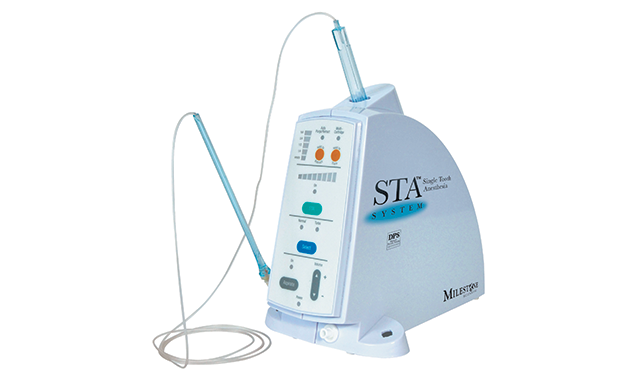Delivering patient-friendly injections with The Wand
How this computer-assisted anesthesia system improves outcomes for pediatric patients.

Dr. Georganne McCandless, DDS, PA, is a pediatric dentist in Texas. With patients ranging in age from infants to adolescents, she strives to provide dentistry in a child-friendly environment. The Wand® computer assisted anesthesia system helps her administer anesthetic injections in a better way than a needle and syringe, an approach Dr. McCandless describes as a game changer.
“What I like best is how parents and patients receive it. It makes giving injections in pediatric dentistry easier as it doesn’t look scary,” she says. “It helps kids get over their fear.”
Getting over fear is an important part of Dr. McCandless’s philosophy. She uses her practice to provide a strong foundation of trust for her patients’ relationship with dental professionals in their lifetime. She uses different approaches between the very young, pre-teens and adolescents to manage their behavior, guiding their dental growth and development to help them avoid dental problems in the future, including being afraid of the dentist.
Trending article: 8 ways to get kids to care about dental hygiene
Dental fear and anxiety, or DFA, is a big problem for the field of pediatric dentistry. According to a 2013 study, anywhere from 5 to 20 percent of children and adolescents experience some degree of DFA. Children who are afraid are often uncooperative in the dental chair, which makes treatment difficult and negatively affects the treatment outcome. In some cases, their resistance makes the dental procedure impossible, which could lead to more severe dental problems for the child in the long run.
Dental anxiety as a child can continue as the child matures. Then, the patient avoids the dentist, which has many detriments to a person’s oral health. Experts agree that making children comfortable in the dental office and addressing DFA before it worsens is a significant concern for pediatric dentists.
Dr. McCandless recommends establishing a “dental home” for children by the time they’re 1 year old so that their first trip to the dentist isn’t due to an emergency. In addition, pediatric patients with a dental home are likely to receive proper preventative care and establish a regular oral health routine. Dr. McCandless sees infants on or before their first birthday at no charge to encourage parents to follow the AAPD guidelines.
In addition to inexperience, several other factors contribute to a child’s fear of the dentist. One of the most significant is how the child’s parents feel about going to the dentist. In other words, when mom and dad are afraid of the dentist, their child will be too.
During the initial exam, Dr. McCandless invites parents to accompany the child. However, she asks that parents allow kids to go solo during future visits, allowing the staff to build rapport and overcome any apprehension the child may have. That said, parents often accompany their children in the treatment room after the initial visit. One of the biggest benefits to Dr. McCandless’ practice is how The Wand promotes parental acceptance.
“The Wand helps put them at ease with me taking care of their children. I often hear comments like, ‘What is that? That is so cool!’ Or, ‘Wow, I wish they had that when I was little,’ and “Can my dentist get one of those?” she says.
Another common source of dental anxiety for children is how dental instruments look. Dr. McCandless knows that most kids feel afraid and nervous when they see a needle and syringe. The Wand helps her administer anesthetic injections without scaring her patients.
“It doesn’t look like a shot, so they are more accepting of it visually, and therefore not afraid,” Dr. McCandless explains. “The Wand looks innocuous and nonthreatening. You can hold it in your hand in an almost hidden way. I refer to it as ‘my pencil’ and tell my patients that I’m drawing a bubble next to their tooth.”
More from the author: Using silver diamine fluoride as a new caries management solution

Dr. McCandless believes providing excellent service at a fair price will encourage parents to continue to bring their children to the dentist. Part of the excellent service is reducing patient (and parental) stress when in the dental chair, which is often achieved through technology. Dr. McCandless invested in The Wand to help make going to the dentist a pleasant and positive experience.
A common misconception children and their parents have is that needles hurt. However, the source of pain during anesthetic injections doesn’t stem from the needle but rather from the flow of anesthetic into the soft tissue.
The Wand reduces the discomfort from the anesthetic. It uses injection technology with a microprocessor embedded in the digital platform to manage a steady flow of anesthetic automatically, regardless of how dense the tissue is at the injection site, resulting in a more comfortable injection.
Dr. McCandless has been practicing pediatric dentistry for almost 20 years, and she’s been using The Wand for 19 of them. Her residency program received The Wand, and she had never used anything else like it. She says it took some time to learn to use it, but the learning curve was worth it.
“Injections are easier, more predictable and, I believe, less painful for the patient,” she says. “I couldn’t recommend this product enough."
Product Bites – November 10, 2023
November 10th 2023The weekly new products podcast from Dental Products Report is back. With a quick look at all of the newest dental product launches, Product Bites makes sure you don't miss the next innovation for your practice. This week's Product Bites podcast features new launches from Amann Girrbach, DMG, Pac-Dent, and ASI Dental Specialties. [4 Minutes]